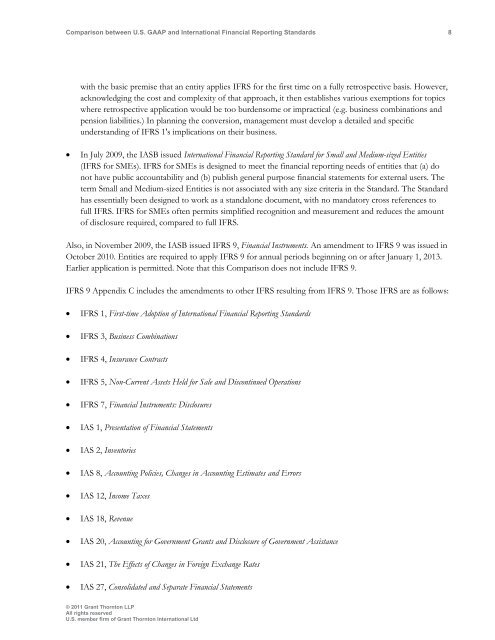Comparison between U.S. GAAP and International ... - Grant Thornton
Comparison between U.S. GAAP and International ... - Grant Thornton
Comparison between U.S. GAAP and International ... - Grant Thornton
Create successful ePaper yourself
Turn your PDF publications into a flip-book with our unique Google optimized e-Paper software.
<strong>Comparison</strong> <strong>between</strong> U.S. <strong>GAAP</strong> <strong>and</strong> <strong>International</strong> Financial Reporting St<strong>and</strong>ards 8<br />
with the basic premise that an entity applies IFRS for the first time on a fully retrospective basis. However,<br />
acknowledging the cost <strong>and</strong> complexity of that approach, it then establishes various exemptions for topics<br />
where retrospective application would be too burdensome or impractical (e.g. business combinations <strong>and</strong><br />
pension liabilities.) In planning the conversion, management must develop a detailed <strong>and</strong> specific<br />
underst<strong>and</strong>ing of IFRS 1's implications on their business.<br />
<br />
In July 2009, the IASB issued <strong>International</strong> Financial Reporting St<strong>and</strong>ard for Small <strong>and</strong> Medium-sized Entities<br />
(IFRS for SMEs). IFRS for SMEs is designed to meet the financial reporting needs of entities that (a) do<br />
not have public accountability <strong>and</strong> (b) publish general purpose financial statements for external users. The<br />
term Small <strong>and</strong> Medium-sized Entities is not associated with any size criteria in the St<strong>and</strong>ard. The St<strong>and</strong>ard<br />
has essentially been designed to work as a st<strong>and</strong>alone document, with no m<strong>and</strong>atory cross references to<br />
full IFRS. IFRS for SMEs often permits simplified recognition <strong>and</strong> measurement <strong>and</strong> reduces the amount<br />
of disclosure required, compared to full IFRS.<br />
Also, in November 2009, the IASB issued IFRS 9, Financial Instruments. An amendment to IFRS 9 was issued in<br />
October 2010. Entities are required to apply IFRS 9 for annual periods beginning on or after January 1, 2013.<br />
Earlier application is permitted. Note that this <strong>Comparison</strong> does not include IFRS 9.<br />
IFRS 9 Appendix C includes the amendments to other IFRS resulting from IFRS 9. Those IFRS are as follows:<br />
<br />
<br />
<br />
<br />
<br />
<br />
<br />
<br />
<br />
<br />
<br />
<br />
<br />
IFRS 1, First-time Adoption of <strong>International</strong> Financial Reporting St<strong>and</strong>ards<br />
IFRS 3, Business Combinations<br />
IFRS 4, Insurance Contracts<br />
IFRS 5, Non-Current Assets Held for Sale <strong>and</strong> Discontinued Operations<br />
IFRS 7, Financial Instruments: Disclosures<br />
IAS 1, Presentation of Financial Statements<br />
IAS 2, Inventories<br />
IAS 8, Accounting Policies, Changes in Accounting Estimates <strong>and</strong> Errors<br />
IAS 12, Income Taxes<br />
IAS 18, Revenue<br />
IAS 20, Accounting for Government <strong>Grant</strong>s <strong>and</strong> Disclosure of Government Assistance<br />
IAS 21, The Effects of Changes in Foreign Exchange Rates<br />
IAS 27, Consolidated <strong>and</strong> Separate Financial Statements<br />
© 2011 <strong>Grant</strong> <strong>Thornton</strong> LLP<br />
All rights reserved<br />
U.S. member firm of <strong>Grant</strong> <strong>Thornton</strong> <strong>International</strong> Ltd
















